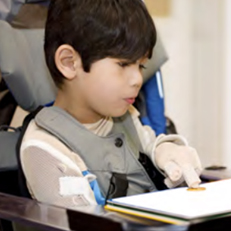
Phone: 212 520 1686
Email: info@yourcpf.org
COMMUNICATION CLASSIFICATION
Cerebral Palsy (CP) describes a group of permanent disorders of the development of movement and posture, causing activity limitations, attributed to non progressive disturbances that occurred in the developing fetal or infant brain. The motor disorders of cerebral palsy are often accompanied by disturbances of sensation, perception, cognition, communication and behavior, epilepsy, and by secondary musculoskeletal problems.

1 IN 5
PEOPLE WITH
CEREBRAL
PALSY
WILL HAVECOMMUNICATION
DIFFICULTIES
The CFCS is a tool used to classify the everyday communication of an individual with cerebral palsy. The CFCS consists of 5 descriptive levels for everyday communication performance.
CFCS LEVELS
-
Level 1
Effective Sender and Receiver with unfamiliar and familiar partners. The person independently alternates between sender and receiver roles with most people in most environments. The communication occurs easily and at a comfortable pace with both unfamiliar and familiar conversational partners. Communication misunderstandings are quickly repaired and do not interfere with the overall effectiveness of the person’s communication. -
Level 2
Effective but slower paced Sender and/or Receiver with unfamiliar and/or familiar partners. The person independently alternates between sender and receiver roles with most people in most environments, but the conversational pace is slow and may make the communication interaction more difficult. The person may need extra time to understand messages, compose messages, and/or repair misunderstandings. Communication misunderstanding are often repaired and do not interfere with the eventual effectiveness of the person’s communication with both unfamiliar and familiar partners. -
Level 3
Effective Sender and Receiver with familiar partners. The person alternates between sender and receiver roles with familiar (but not unfamiliar) conversational partners in most environments. Communication is not consistently effective with most unfamiliar partners, but is usually effective with familiar partners. -
Level 4
Inconsistent Sender and/or Receiver with familiar partners. The person does not consistently alternate sender and receiver roles. This type of inconsistency might be seen in different types of communicators including: a) an occasionally effective sender and receiver; b) an effective sender but limited receiver; c) a limited sender but effective receiver. Communication is sometimes effective with familiar partners. -
Level 5
Seldom Effective Sender and Receiver even with familiar partners. The person is limited as both a sender and a receiver. The person’s communication is difficult for most people to understand. The person appears to have limited understanding of messages from most people. Communication is seldom effective even with familiar partners.
CFCS Descriptors: Hidecker et al (2001) Developmental Medicine and Child Neurology, 53(8):704-10.






